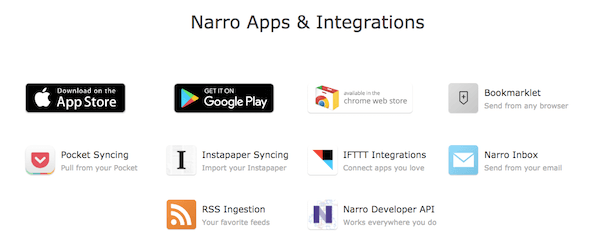Want to try some new social media marketing tools?
Wondering which apps can enhance your social media audio, video, and images?
#1: Narro

Narro is an app that converts text articles into audio files so you can listen on the go.
To convert a text article into an audio file, you can use the Narro bookmarklet, Chrome browser extension, or iOS or Android app. Narro then adds the audio file to your listening feed. You select from a number of male and female voices, and you can alter the speed to make the voice sound more natural.
For example, if you don’t have time to read today’s article on Social Media Examiner, you would either click the extension or bookmarklet. Narro will then scan that article’s text, convert it into an audio file, and put that file into your personal feed. If you subscribe to a feed (like Overcast), the audio file of the article shows up in your feed after a few minutes or so.
#2: Workfrom
Workfrom helps you find remote working spaces and connect with people who use them. To search for a remote workspace, you can use the website or the iOS or Android app.
Workfrom takes you through all of the factors you need to consider when deciding whether to work at a remote location. For instance, you learn whether a space is public or private, what the WiFi speeds are, information about any WiFi costs, whether food and drinks are available, if it’s open late, whether it’s indoor or outdoor, quiet or communal, and more.
People traveling to San Diego for Social Media Marketing World who will be there days before or after the event may need an alternative to working in a hotel room. Workfrom can help them find locations.
#3: Loom
Loom is a Chrome browser extension that creates a shareable video as soon as you finish recording.
When you want to share how something works or speak to your audience, Loom is a great choice, especially when video is the ideal way to communicate your message.
Because Loom creates a link that recipients can access without an account, Loom is an easy way to share video over email, instead of writing text emails back and forth to clarify certain points. In Gmail, you can even play the video right in the message window.
After you install the Loom Chrome extension, you can record what you’re doing on-screen or with your computer’s camera. When you’re done recording, a browser tab opens with a URL you can copy and share in an email or anywhere on the web.
#4: TwIM
TwIM is an iOS app that’s dedicated to Twitter direct messages. It’s like Facebook Messenger for Twitter.
Compared with the Twitter app, TwIM gives you nuanced control over your Twitter notifications. For example, you can see a notification only when you receive a Twitter direct message so you’ll know when you have a message before you open the app.
With TwIM, you can also search for people by username to start a conversation; send full messages with emojis; block and unblock users; reply to people using text, photos, maps, or URLs; and more.
TwIM could be a great new tool for social media managers who are heavily into providing customer service or interaction with fans and friends in Twitter direct messages.
#5: Reverb
Reverb is an interface that allows you to use Amazon Alexa instead of other artificial intelligence apps such as Siri on your Mac OS or iOS device.
Ask Alexa a question and it gives you a response type. You can connect Alexa to your home to turn on the lights, ask Alexa for weather and traffic reports, and so on.
Reverb also enables you to be less dependent on Amazon devices such as the Echo or the Echo Dot to access Alexa. For instance, if you have a Dot in your office but you’re on the go, you can pull out your phone, open Reverb, and ask Alexa anything. Reverb has all of the benefits of the service without the hardware.
This resource works on desktop for Mac, and on mobile and tablets for iOS and Android.
#6: Just Good Copy

Just Good Copy offers inspiration for writing your email copy. The website is like a swipe file for writing emails.
To find inspiring emails, go to GoodEmailCopy.com and enter the type of email you need to write in the search bar. Your search results show existing emails from familiar companies such as Upwork, Buffer, Trello, Salesforce, Dropbox, Evernote, and Pinterest.
Instead of searching, you can also click a tag for a common type of email. The tags look like colorful bubbles and reflect popular types of email such as thank you, welcome, nurture, maintenance, canceled subscription, and others.
#7: TouchRetouch
TouchRetouch is a cool tool for mobile picture-takers who want to edit things out of their photos such as a photo bomber or utility lines.
The TouchRetouch app, available for iOS and Android, is incredibly easy to use. After you open a photo in the app, you select a brush or selection tool and run your finger over the object or line you want to remove.
The tools create a mask over the undesirable image content, and the app analyzes what’s around the masked area and wipes it out. Although the analysis isn’t 100% perfect, the app does a pretty good job of removing what you mask.
#8: TabCloud
TabCloud helps you manage your browser tabs by opening groups of bookmarked websites all at once.
For example, if checking major social networks is one of your daily tasks, TabCloud can help you open those sites quickly and easily.
To set up the group, set the tabs for Facebook, Twitter, Instagram, and any other sites you need such as your social media management software. Then give the group a name such as Social Channels. After you set up the group, you simply click its button and all of those websites open in your browser.
You can also sync TabCloud with other browsers and use the website favicons for easy recognition. It’s a browser extension for Chrome and Firefox, as well as an Android app. The iOS app is coming soon.
#9: Markticle
With Markticle, you can bookmark online articles and mark your progress so you can pick up right where you left off. With the notes and sharing features, you can also share your comments about specific content in the article through Facebook or Twitter.
Markticle is available as a Chrome extension and Android app. After you install Markticle, open the article you want to read, select the text where you’re leaving off, and press M to mark that text. You then have the option to leave a note or share the article.
#10: Emojipedia

With Emojipedia, you can find the emoji you’re looking for right away.
Scanning a full emoji keyboard or list can involve a lot of scrolling. However, Emojipedia allows you to type a search term and see only relevant emojis.
For example, for a Facebook post, I wanted to add an emoji of a person making a muscle with their arm. When I searched for “muscles,” Emojipedia showed an emoji called “flexed biceps.” I clicked the emoji, and then copied and pasted it directly into my Facebook post.
Because emojis look slightly different on the various platforms (Facebook versus Google, etc.), Emojipedia also shows how the emoji looks on each platform.
Emojis are great for social media posts because they evoke emotion and increase engagement. An emoji can also punctuate your post, save space, and allow you to be creative and have fun.










